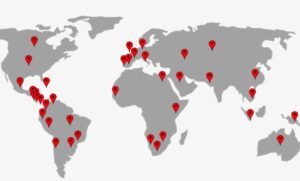Goiânia is the capital of the state of Goiás. It is located in the Center-West Region of Brazil, in a plateau zone of smooth relief. The city was planned, that is, it was built from a specific urban project. Its construction took place between 1933 and 1942 and was an important milestone for the settlement of the state of Goiás.
Currently, Goiânia has more than 1.4 million inhabitants. It is an important center of commerce and services in Brazil, in addition to having a modern infrastructure and being very wooded. In addition, it is quite representative when it comes to elements of Goiás culture, such as cuisine.
The settlement of the central-west region took place in the company of the pioneers and discovered by a Portuguese explorer (Bartolomeu Bueno) who had as one of their goals to find gold in this vast territory inhabited by indigenous people and isolated from the rest of the colony. The discovery of gold made possible a rapid migration to the banks of its rivers, initiating the emergence of citadels and villages. As the rapid rise of gold, its decline was also rapid, as a result of which there was the emergence of towns and cities formed by a white minority population and the majority of mestizos, mulattos and slaves (SILVA, Washington Maciel). Currently, its economic activity is strong in agriculture and livestock.
This work Master’s Dissertation presented to the Postgraduate Program in Health Sciences of the Federal University of Goiás to obtain the Master’s Degree in Health Sciences from neurologist TAYSA ALEXANDRINO GONSALVES JUBÉ RIBEIRO and having as advisor PHD and professor Denise Sisterolli Diniz and co-supervisor: PHD and professor. Regina Maria Papaz Alvarenga.
It basically consisted of bringing together patient groups from different sources within the specialized medical care for demyelinating diseases.
Through a retrospective survey of the medical records of patients treated in three sources: neurologists, multiple sclerosis reference centers in the city of Goiânia and the high-cost drug dispensing register of the Goiás state pharmacy, the number of patients with MS residents in Goiânia, and based on these data, the calculation of gross prevalence rates was performed, the socio-demographic profile was analyzed and the capture-recapture method was applied in the prevalence study. Results: We found 318 patients with multiple sclerosis excluding the intersections between the sources, resulting in a crude prevalence rate of 22.2/100,000 population. With the application of the capture-recapture method, the prevalence found was 26.4/100,000 inhabitants. Of the 318 MS cases found, the majority were women (76.7%), white (77.4%), and with a relapsing-remitting clinical course (90.8%).
First group: Juarez Barbosa State Dispensing Center.
Second group: Referral Center of Hospital das Clínicas of UFG and HGG.
Third group: Specialist physicians who treat Multiple Sclerosis in their office.
A form (questionnaire) was made available with the main personal data and clinical characteristics of the patients, protecting their identity, but that duplicity could be identified and then tabulated the data.
Results: The distribution of patients with multiple sclerosis, according to the sources, is shown in Figure 19. In Source 1 (register of the Juarez Barbosa High-Cost Medication Dispensing Center) 249 cases were found, 78.3%. In Source 2 (databases of Reference Centers for the Treatment of Patients with Multiple Sclerosis) 85 patients were obtained, or 26.7%, and finally, in Source 3 (neurologists from the city of Goiânia) 101 patients, or 31.8%, were obtained. 6.3 Analysis by the log-linear model During the analysis, different log-linear models were obtained and we retain the model with the lowest Akaike Information Criterion (AIC), since the best statistical model is the model with the lowest AIC (Figure below). Figure 19. Venn Diagram representation of the study sources. F1 – Juarez Barbosa High-Cost Medication Dispensing Center, F2- Reference Centers for the Treatment of Patients with Multiple Sclerosis – HC/HGG, F3- Neurologists.

- Society

Membership
Support our mission by becoming a member

Public Health Policy Center
Explore the society's public health initiatives

Meet the community
See what our members have been working on
- Journal
- Author Center
- Membership